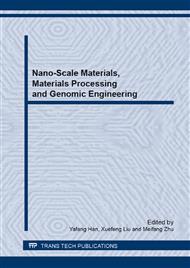[1]
Guo-an Cheng, Dong-yan Han, Chang-lin Liang, Xiao-ling Wu, Rui-ting Zheng, Influence of residual stress on mechanical properties of TiAlN thin films, Surf. Coat. Technol. 228 (2013) S328-S330.
DOI: 10.1016/j.surfcoat.2012.05.108
Google Scholar
[2]
K. Singh, P.K. Limaye, N.L. Soni, A.K. Grover, R.G. Agrawal, A.K. Suri, Wear studies of (Ti–Al)N coatings deposited by reactive magnetron sputtering, Wear. 258 (2005) 1813-1824.
DOI: 10.1016/j.wear.2004.12.023
Google Scholar
[3]
V.A. Belous, V.V. Vasyliev, V.S. Goltvyanytsya, S.K. Goltvyanytsya, A.A. Luchaninov, E.N. Reshetnyak, V.E. Strelnitskij, G.N. Tolmacheva, O. Danylina, Structure and properties of Ti–Al–Y–N coatings deposited from filtered vacuum-arc plasma, Surf. Coat. Technol. 206 (2011) 1720-1726.
DOI: 10.1016/j.surfcoat.2011.09.061
Google Scholar
[4]
L.J. Liu, D.K. Sood, R.R. Manory, W. Zhou, Modification of tribomechanical properties of commercial TiN coatings by carbon ion implantation, Surf. Coat. Technol. 71(1995) 159-166.
DOI: 10.1016/0257-8972(94)01015-b
Google Scholar
[5]
R.R. Manory, C.L. Li, C. Fountzoulas, J.D. Demaree, J.K. Hirvonen, R. Nowak, Effect of nitrogen ion-implantation on the tribological properties and hardness of TiN films, Mater. Sci. Eng. A. 253 (1998) 319-327.
DOI: 10.1016/s0921-5093(98)00743-6
Google Scholar
[6]
J. Narojczyk, Z. Werner, D. Morozow, W. Tuszynski, Wear resistance of TiN coatings implanted with Al and N ions, Vacuum. 81 (2007) 1275-1277.
DOI: 10.1016/j.vacuum.2007.01.022
Google Scholar
[7]
Ko-Wei Weng, Tai-Nan Lin, Da-Yung Wang, Tribological property enhancement of CrN films by metal vapor vacuum arc implantation of Vanadium and Carbon ions, Thin Solid Films. 516 (2008) 1012-1019.
DOI: 10.1016/j.tsf.2007.06.162
Google Scholar
[8]
Bin Deng, Ye Tao, Hongliang Liu, Peiying Liu, Influence of niobium ion implantation on the microstructure and tribological properties of TiAlN coatings, Surf. Coat. Technol. 228 (2013), S554-S557.
DOI: 10.1016/j.surfcoat.2012.04.022
Google Scholar
[9]
Yao-Can Zhu, K. Fujita, N. Iwamoto, H. Nagasaka, T. Kataoka, Influence of boron ion implantation on the wear resistance of TiAlN coatings, Surf. Coat. Technol. 158 -159 (2002) 664-668.
DOI: 10.1016/s0257-8972(02)00238-4
Google Scholar
[10]
J.F. Ziegler, J.P. Biersack, U. Littmark, Stopping Powers and Range of Ions in Mater, Pergamon Press, New York, 1985.
Google Scholar
[11]
Y.F. Xu, P.W. Shum, Z.F. Zhou, K.Y. Li, Effect of high-energy carbon ion implantation on Ti–Al–Si–N coatings by metal vapour vacuum arc, Surf. Coat. Technol. 204(2010) 1914-1918.
DOI: 10.1016/j.surfcoat.2009.09.006
Google Scholar
[12]
S. Badrinarayanan, S. Sinha, X-ray photoelectron spectroscopy studies of the reaction of N+ 2 -ion beams with niobium and tantalum metals, J. Appl. Phys. 69(1991) 1141-1146.
DOI: 10.1063/1.347294
Google Scholar
[13]
B.M. Biwer, S.L. Bernasek, Electron spectroscopic study of the iron surface and its interaction with oxygen and nitrogen, J. Electron. Spectrosc. Relat. Phemon. 40(1986) 339-351.
DOI: 10.1016/0368-2048(86)80044-5
Google Scholar
[14]
B. Koscielska, A. Winiarski, B. Kusz, Structure and electrical properties of nitrided NbN-TiN sol-gel derived films, J. Non-Cryst. Solids. 355 (2009) 1342-1346.
DOI: 10.1016/j.jnoncrysol.2009.05.023
Google Scholar
[15]
G. Jouve, C. Severac, S. Cantacuzene, XPS study of NbN and (NbTi)N superconducting coatings, Thin Solid Films. 287 (1996) 146-153.
DOI: 10.1016/s0040-6090(96)08776-7
Google Scholar
[16]
J.C. Caicedo, G. Zambrano, W. Aperador, L. Escobar-Alarcon, E. Camps, Mechanical and electrochemical characterization of vanadium nitride (VN) thin films, Appl. Surf. Sci. 258 (2011) 312-320.
DOI: 10.1016/j.apsusc.2011.08.057
Google Scholar
[17]
G.S. Kim, S.Y. Lee, J.H. Hahn, Synthesis of CrN/AlN superlattice coatings using closed-field unbalanced magnetron sputtering process, Surf. Coat. Technol. 171 (2003) 91-95.
DOI: 10.1016/s0257-8972(03)00244-5
Google Scholar
[18]
G.W. Stachowiak, A.W. Batchelor, Engineering Tribology, third ed., Elsevier, Butterworth-Heinemann, Amsterdam, Netherlands, 2005, 461-499.
Google Scholar


